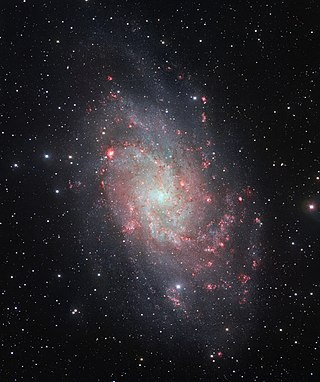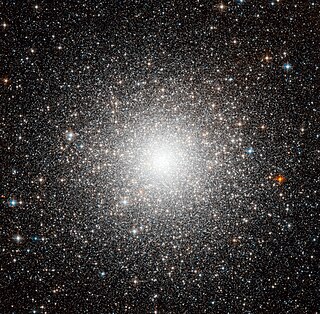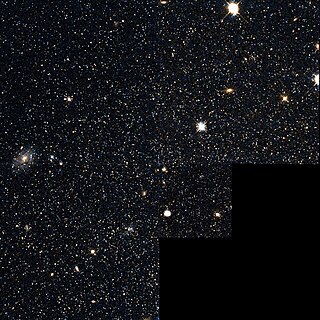
A globular cluster is a spheroidal conglomeration of stars that is bound together by gravity, with a higher concentration of stars towards their centers. They can contain anywhere from tens of thousands to many millions of member stars, all orbiting in a stable, compact formation. Globular clusters are similar in form to dwarf spheroidal galaxies, and the distinction between the two is not always clear. Their name is derived from Latin globulus. Globular clusters are occasionally known simply as "globulars".

Star clusters are large groups of stars held together by self-gravitation. Two main types of star clusters can be distinguished: globular clusters are tight groups of ten thousand to millions of old stars which are gravitationally bound, while open clusters are more loosely clustered groups of stars, generally containing fewer than a few hundred members, and are often very young. Open clusters become disrupted over time by the gravitational influence of giant molecular clouds as they move through the galaxy, but cluster members will continue to move in broadly the same direction through space even though they are no longer gravitationally bound; they are then known as a stellar association, sometimes also referred to as a moving group.

The Andromeda Galaxy is a barred spiral galaxy and is the nearest major galaxy to the Milky Way. It was originally named the Andromeda Nebula and is cataloged as Messier 31, M31, and NGC 224. Andromeda has a D25 isophotal diameter of about 46.56 kiloparsecs (152,000 light-years) and is approximately 765 kpc (2.5 million light-years) from Earth. The galaxy's name stems from the area of Earth's sky in which it appears, the constellation of Andromeda, which itself is named after the princess who was the wife of Perseus in Greek mythology.

The Triangulum Galaxy is a spiral galaxy 2.73 million light-years (ly) from Earth in the constellation Triangulum. It is catalogued as Messier 33 or NGC (New General Catalogue) 598. With the D25 isophotal diameter of 18.74 kiloparsecs (61,100 light-years), the Triangulum Galaxy is the third-largest member of the Local Group of galaxies, behind the Andromeda Galaxy and the Milky Way.

RR Lyrae variables are periodic variable stars, commonly found in globular clusters. They are used as standard candles to measure (extra) galactic distances, assisting with the cosmic distance ladder. This class is named after the prototype and brightest example, RR Lyrae.

Omega Centauri is a globular cluster in the constellation of Centaurus that was first identified as a non-stellar object by Edmond Halley in 1677. Located at a distance of 17,090 light-years, it is the largest-known globular cluster in the Milky Way at a diameter of roughly 150 light-years. It is estimated to contain approximately 10 million stars, with a total mass of 4 million solar masses, making it the most massive known globular cluster in the Milky Way.

Messier 2 or M2 is a globular cluster in the constellation Aquarius, five degrees north of the star Beta Aquarii. It was discovered by Jean-Dominique Maraldi in 1746, and is one of the largest known globular clusters.

Messier 54 is a globular cluster in the constellation Sagittarius. It was discovered by Charles Messier in 1778 and then included in his catalog of comet-like objects.

Messier 56 is a globular cluster in the constellation Lyra. It was discovered by Charles Messier in 1779. It is angularly found about midway between Albireo and Sulafat. In a good night sky it is tricky to find with large (50–80 mm) binoculars, appearing as a slightly fuzzy star. The cluster can be resolved using a telescope with an aperture of 8 in (20 cm) or larger.

Messier 62 or M62, also known as NGC 6266 or the Flickering Globular Cluster, is a globular cluster of stars in the south of the equatorial constellation of Ophiuchus. It was discovered in 1771 by Charles Messier, then added to his catalogue eight years later.

Messier 90 is an intermediate spiral galaxy exhibiting a weak inner ring structure about 60 million light-years away[a] in the constellation Virgo. It was discovered by Charles Messier in 1781.

Messier 110, or M110, also known as NGC 205, is a dwarf elliptical galaxy that is a satellite of the Andromeda Galaxy in the Local Group.

NGC 2419 is a globular cluster in the constellation Lynx. It was discovered by William Herschel on December 31, 1788. NGC 2419 is at a distance of about 300,000 light years from the Solar System and at the same distance from the Galactic Center.

Andromeda I is a dwarf spheroidal galaxy (dSph) about 2.40 million light-years away in the constellation Andromeda. Andromeda I is part of the local group of galaxies and a satellite galaxy of the Andromeda Galaxy (M31). It is roughly 3.5 degrees south and slightly east of M31. As of 2005, it is the closest known dSph companion to M31 at an estimated projected distance of ~40 kpc or ~150,000 light-years.
Andromeda III is a dwarf spheroidal galaxy about 2.44 million light-years away in the constellation Andromeda. It is part of the Local Group and is a satellite galaxy of the Andromeda Galaxy (M31). The galaxy was discovered by Sidney van den Bergh on photographic plates taken in 1970 and 1971.

Nicholas Ulrich Mayall was an American observational astronomer. After obtaining his doctorate from the University of California, Berkeley, Mayall worked at the Lick Observatory, where he remained from 1934 to 1960, except for a brief period at MIT's Radiation Laboratory during World War II.

Georges Meylan is a Swiss astronomer, born on July 31, 1950, in Lausanne, Switzerland. He was the director of the Laboratory of Astrophysics of the Swiss Federal Institute of Technology (EPFL) in Lausanne, Switzerland, and now a professor emeritus of astrophysics and cosmology at EPFL. He is still active in both research and teaching.

The Gaia Sausage or Gaia Enceladus is the remains of a dwarf galaxy that merged with the Milky Way about 8–11 billion years ago. At least eight globular clusters were added to the Milky Way along with 50 billion solar masses of stars, gas and dark matter. It represents the last major merger of the Milky Way.
Robert Michael Rich is an American astrophysicist. He obtained his B.A. at Pomona College in 1979 and earned his Ph.D. from the California Institute of Technology in 1986 under thesis supervisor Jeremy R. Mould. He was a Carnegie Fellow at Carnegie/DTM until 1988 when he joined the faculty of Columbia University where he was the doctoral thesis adviser to Neil deGrasse Tyson, and is on the faculty of the University of California, Los Angeles.


















